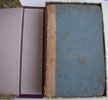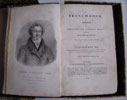The French Cook.
A SYSTEM OF FASHIONABLE AND ECONOMICAL COOKERY, FOR THE USE OF ENGLISH FAMILIES. "True taste is an excellent economist." - Rogers. BY LOUIS EUSTACHE UDE. CO-DEVANT COOK TO LOUIS XVI. AND THE EARL OF SEFTON, AND LATE STEWARD TO HIS ROYAL HIGHNESS THE DUKE OF YORK. NINTH EDITION, ENLARGED. LONDON W.H. AINSWORTH, 23, OLD BOND-STREET; SOLD ALSO BY HURST AND CO., ST. PAUL'S CHURCHYARD; SHERWOOD AND CO., PA-TERNOSTER-ROW; SIMPKIN AND MARSHALL, STATIONERS-HALL-COURT; J. ANDREWS, NEW BOND-STREET; AND W. SAMS, ST JAMES'S-STREET; WILSON AND SONS, YORK; H. MOZELY, DERBY; W. AND W. CLARKE, MANCHESTER; G. AND J. ROBINSON, LIVERPOOL; OLIVER AND BOYD, EDINBURGH; AND WESTLEY AND TYRRELL, DUBLIN. 1827.
210x130 mm. 12p Advertisments. 1fep. (1)Frontispiece portrait of Ude. (drawn from life by Albert Hoffay). Title page. [1] (1)4 Reviews of Ude's book. (1)vi-xxiv Preface. xxv-xxxviii Advice to Cooks. Eight plates numbered 1-8. (1)2-480. (1)482-496 INDEX. 4p Advertisements (2 pages are an Advertisement of Jarrin's 'Italian Confectioner'). 1fep. Original slightly soiled blue cardboard boards and browned paper spine with printed label. Original untrimmed wide margined pages. Feps and frontis very lightly browned, but internally quite clean and bright. The spine is split but still holding. The back board is almost loose but holding. Housed in a beautiful clam-shell case with modern dark brown half calf and marbled boards. Raised bands to spine with gilt dentelles in the compartments. With a red label with gilt lettering. Overall a very nice copy in its original state. Hence the clam-shell box.
- The vain and extravagant Louis Eustache Ude – born in France circa 1769 died 10th April, 1846. He first published in 1813 his important cookbook ‘The French Cook’. Eustache's career in the Kitchen started with his father who had worked in the kitchens of Louis XVI, where he also got Eustache work as an apprentice.". Ude also worked for Napoleon's mother for 2 years. After arriving in England, he was firstly employed by William Philip Molyneux, the 2nd Earl of Sefton at Croxteth Hall. He stayed in service to the Earl, a well-known gourmet, for almost 20 years. Next, for the Duke of York, George III's second son. After the Duke's passing, Ude was taken on as Maitre d’ Hotel at Crockford's famous gaming club for a starting salary of 1200 pounds a year. The owner and founder, William Crockford, had a very interesting and colourful past. Online information has him as a fishmonger in Fleet Street with a sideline in bookmaking and such small-scale swindles as the three-card trick. He mastered whist, piquet, and cribbage, which consequentially made him rich. He also backed horses, and by 1809 he was a familiar figure at the races, which also brought into contact with the rich and famous. In 1816 he bought a quarter-share in a gambling tavern in St. Jame's, but Crockford realized that this tavern could only have a limited success. He knew that the most popular clubs were so because they were selective, and that if he wanted to compete with them he would have to plan on a much grander scale, and go all out to get the top people as members. So after winning a large sum of money (£100,000, according to one story) either at cards or just by running the gambling establishment, he built in 1827 a luxuriously decorated gambling house at 50 St. James's Street in London, also buying four adjoining houses around the corner. To ensure its social exclusiveness, he organized the place as a club with a regular membership. Crockford's Club, as it was called, quickly became the rage; almost every English celebrity from the Duke of Wellington on down hastened to become a member, as did many ambassadors and other distinguished foreigners. Into this refined atmosphere Ude was brought as maitre'd of the club's exquisite restaurant, where he stayed until 1839. His reputation was made. He offered the best food and the best wines, all provided gratis to the clients. Ude was eventually earning a huge salary of £4000 annually for his services – (the equivalent of £371,000 using the GDP deflator up to 2016). On quitting Crockfords, ironically in a dispute over his pay, he was succeeded by the equally famous chef Charles Elme Francatelli. Gambling houses were illegal at this time. Crockford was regularly charged with operating an illegal club but due to his protection in high circles he was never convicted. As a result of these and other investigations in 1844 by a Parliamentary Select Committee, the Gaming Act 1845 came into being, the principle provision of which was to deem a wager unenforceable as a legal contract. This remained in force until 1 September 2007. Crockford made a series of very poor investments and died on 24 May 1844 leaving little of his considerable fortune to his wife Sarah. The fortunes of Crockfords Club also went downhill immediately after his death; the building went through several hands before emerging with a cleansed reputation as the Devonshire Club. Ude’s vanity was so well known he may have been tickled to know that Mrs Beeton (who in her famous book, tried to offer cost effective recipes put together by over 2000 recipe researcher’s) offered only one recipe herself – Ude’s wildly expensive Turtle Soup recipe. It is assumed that the first recipe for soufflé appeared in Vincent La Chapelle’s book ‘Le Cuisinier Moderne, 1742. Actually the word soufflé first appeared in English in Ude’s ‘The French Cook’ 1813. The PRB&M Co. informs us - "Byron swiped the names of many of Ude's dishes for use in canto 15, stanzas 62–74 of “Don Juan,” and indeed two of Ude's suggested course progressions for stanza 63 (see p. 426)" - Fascinating ! He was buried at General Cemetery of All Souls, Kensal Green amongst princes and paupers, the great and the good, the famous and the infamous with over 1500 notable personalities -- including over 550 with entries in the Dictionary of National Biography as well as his great compatriot Alexis Soyer. No doubt he would feel at home.





click on image to enlarge

Antiquarian category
ref number:
11055